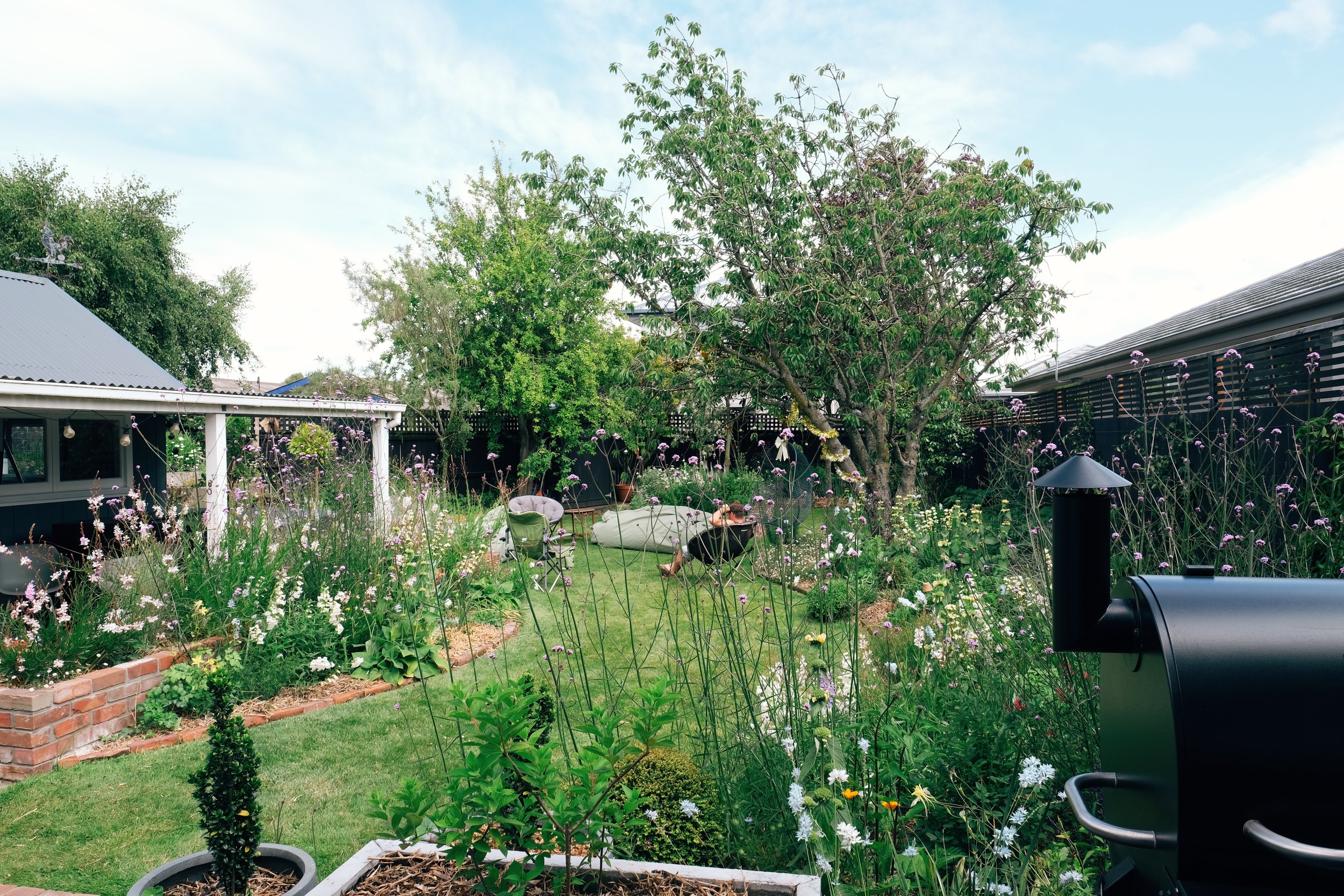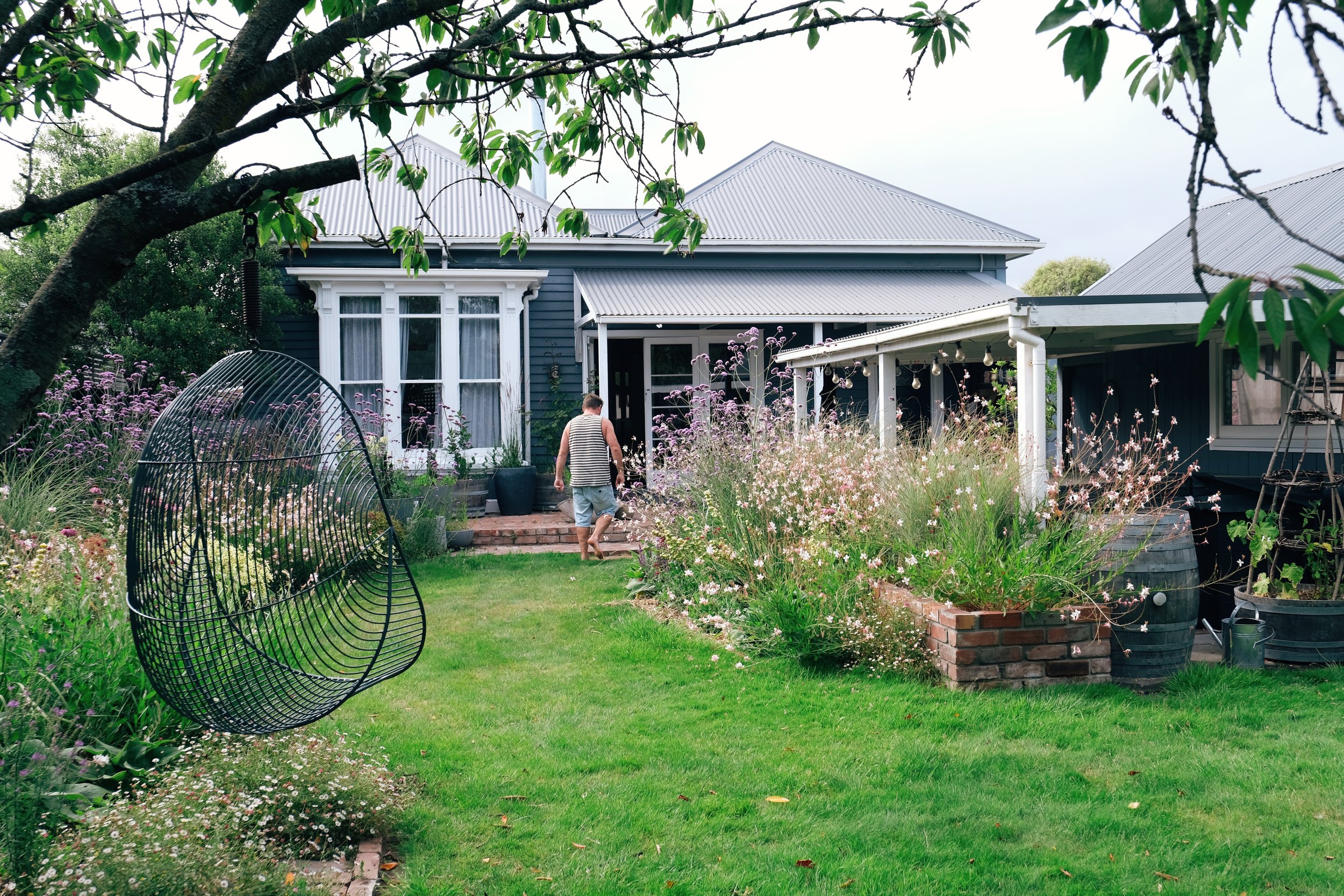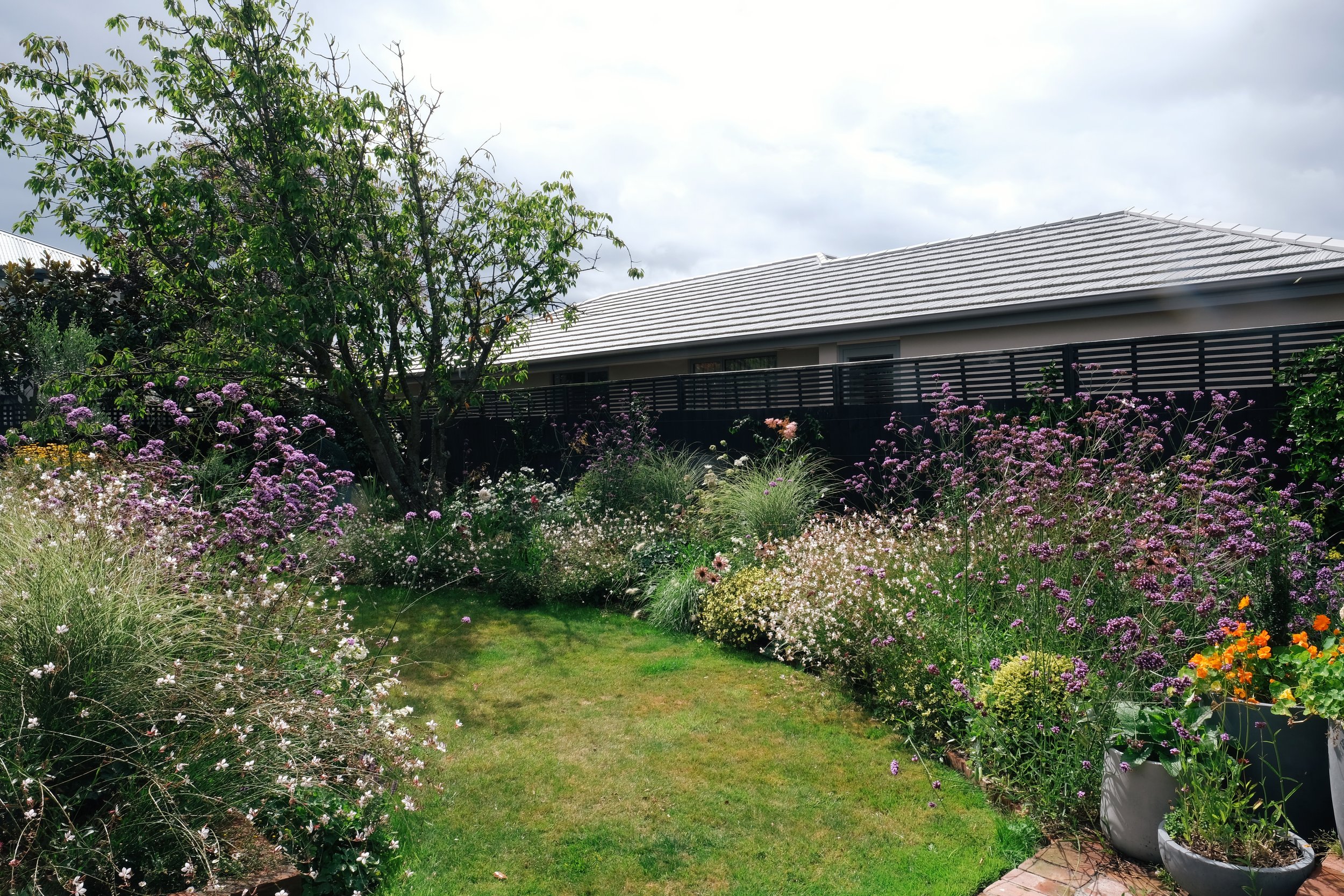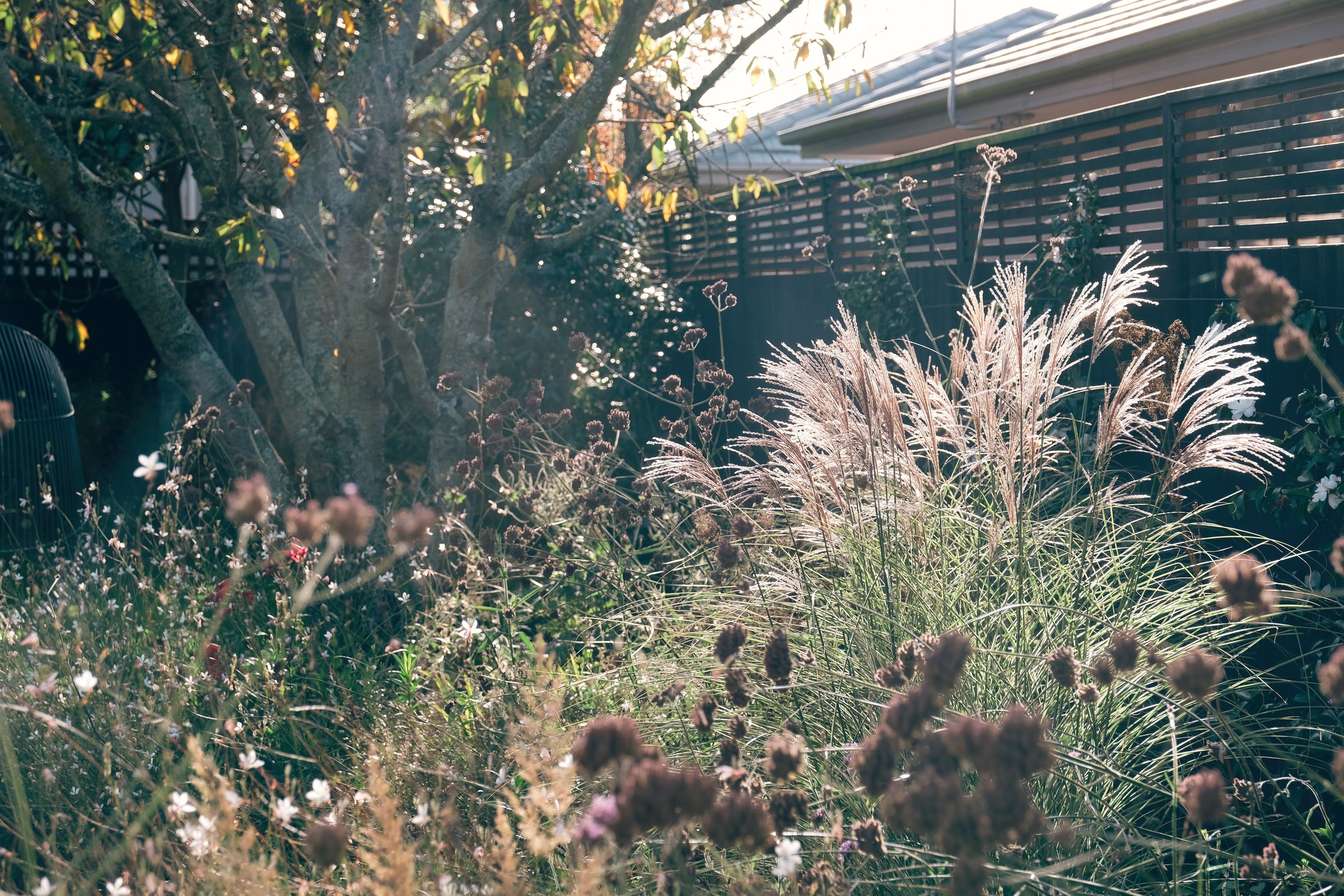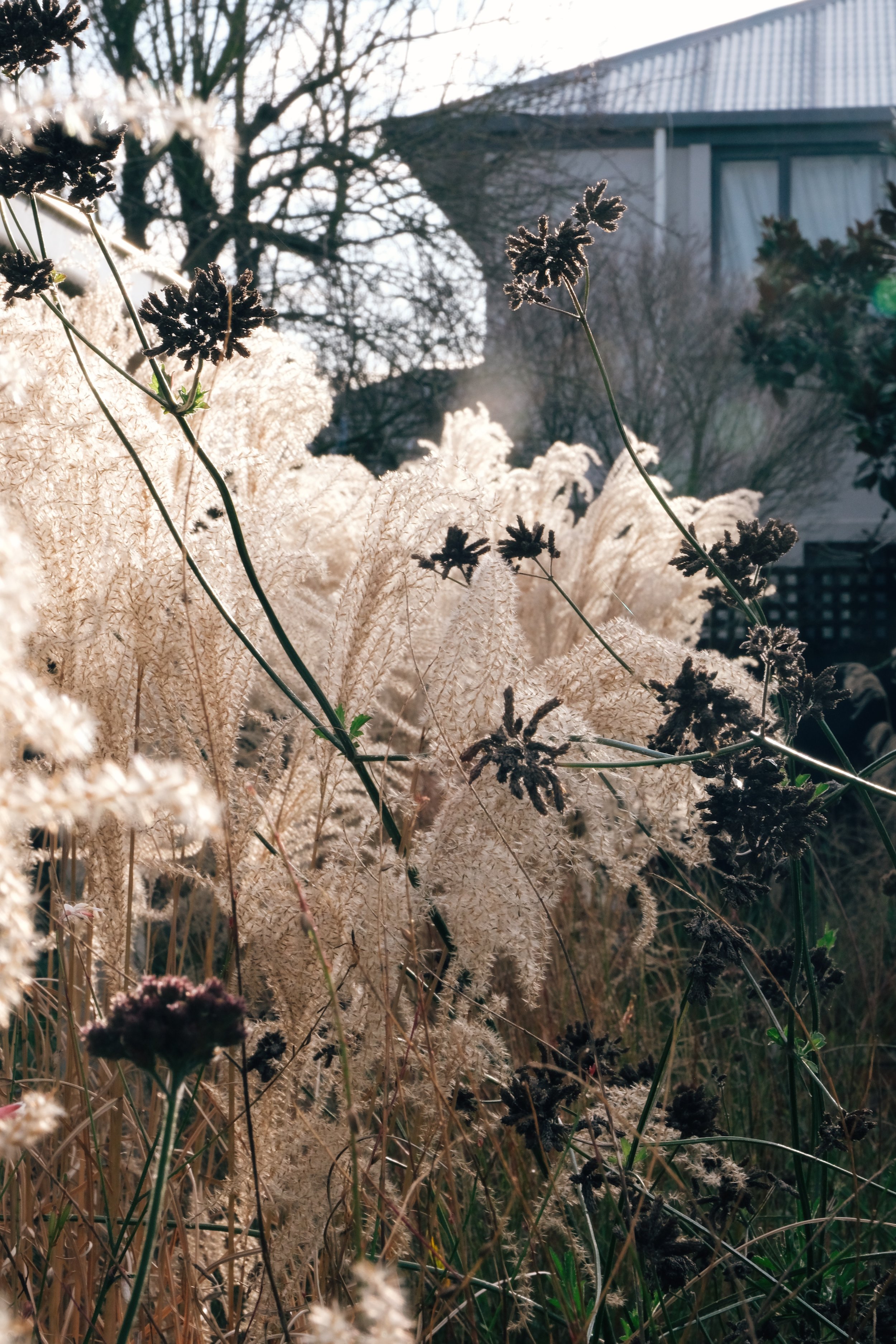MISCANTHUS
Miscanthus ‘Morning Light’ glowing in the autumn late afternoon light.
This has been my first year with the company of grasses in my garden. As a grassy virgin of sorts, I picked Miscanthus sinensis ‘Morning Light’ as my gateway to this vibe.
Only after buying eight plants for my urban plot did I stumble across a stand of it in full maturity in someone else’s (larger) garden, gulping at my massive overcommitment in purchasing! Left undivided they certainly expand to take up their 1m radius (minimum) but lucky for me I have a sister with an enormous new garden to fill, so some energetic division every second spring or so will keep mine as I desire.
SPRING
Using my own garden as an example, these beds are only just passed their first 12 months in the ground.
See top right of raised bed - New growth on the grasses softens the fresh zest of early spring planting and is at a suitable height to accent rather than crowd them.
Barely perceivable, low dots of miscanthus can be seen in garden bed to the right and along the raised bed to the left with spring planting (in its first spring since planting).
EARLY SUMMER
It’s gently variegated leaves weave through emerging early summer perennials like gaura and sisyrinchium.
As the early summer perennials gain height, the miscanthus gently joins them. Barely perceivable here.
Early summer miscanthus dot between perennials in the raised bed to the left.
As a newbie, I can say that I have thoroughly enjoyed all aspects of their ever-changing annual cycle. From a freshly chopped back clump in late winter to their muted green, lightly variegated fresh growth in spring. Their height and feathery presence seemed to perfectly complement the plants around them at any given time, acting as a soft foil to the shorter spring specimens and then a taller textural support act amid my wild and frothy summer show.
It’s in autumn and then winter (at their full height maturity of around 150 - 170cm), that I have felt their positive presence the most. While their perennial bedmates begin to crackle and recede, they send forth unravelling spikes of soft amber flowers. These open and shift in the wind like fans and I simply marvelled as they transformed in colour through warm beige tones then very fluffy white as they set seed in the winter months. It’s at this time, as the rest of the skeletal perennial remains look past their artful best, that their leaves turn to burnt orange and they distract the eye from all the weeding and mess that hasn’t been attended to.
MID SUMMER
Summer is getting going here and the miscanthus are too. Just visible in the planting in the raised bed to the right.
Pale green and feathery miscanthus can be spotted in the centre of the border here in the height of summer.
“Their height and feathery presence seemed to perfectly complement the plants around them at any given time, acting as a soft foil to the shorter spring specimens and then a taller textural support act amid my wild and frothy summer show. ”
Melding softly between the perennials it is a quiet attractive filler.
AUTUMN
Freshly unravelled miscanthus blooms now take the spotlight. They were so beautiful in the autumn light and very friendly garden mates with the gaura and Verbena bonariensis still in flower.
In researching miscanthus beyond my own garden borders I discovered a whole New Zealand site dedicated to its use as an ‘energy crop’. They see the potential for farmers to grow (a very large, hybrid sterile variety) at scale for use as animal bedding, boiler fuel (in place of coal) where it can be pressed into wood pellets, as garden mulch and even in the production of renewable diesel. It can also vastly reduce nitrogen leaching into groundwater and streams when planted to absorb effluent which is a byproduct of dairy farms. As a perennial crop it will return each year and its strong and deep root systems reduce its needs for irrigation in comparison to other crops like maize.
This article focused on the positive results of Lincoln University trials is interesting too!
WINTER
June temps (early winter) start to turn to the miscanthus leaves a pleasing orange. Their flowers are now cream but still quite defined.
Native to Asia, miscanthus can be seen widely in Japanese grasslands where it has a rich history intertwined with their culture. The genus of miscanthus has about 20 species with its name deriving from the Greek words miskos meaning ‘stalk’ and anthos meaning ‘flower’.
In terms of growing miscanthus in our own gardens, there are options beyond my own tested ‘Morning Light’. A popular species Miscanthus sinensis ‘Gracillimus’ grows a little taller than my ones up to 180 cm and has a non-variegated green leaf. For some fun, you could also research Miscanthus sinensis ‘Zebrinus’ which features amazing ‘striped’ foliage - growing larger again at 1.5 m wide x 2 m high. A more compact variety that appears popular in Australia and the Northern Hemisphere is Miscanthus sinensis ‘Kleine Fontaine’ - growing 60-90 cm wide and 120 cm tall. My search for it in NZ hasn’t come to much fruition.
Miscanthus perform best in full sun, a lesson I learnt well after I planted one in full fence shade where it withered and sulked before being moved. Once established they are considered drought tolerant as well as being suitable to salty coastal environments. Naturally, they prefer moist, well-drained soils - in saying that, my soil is quite fertile but clay-based, which inhibits drainage a little. I also water the bare minimum I can get away with, and it was the miscanthus in the planters that may have suffered due to this at times, while the others in the ground held strong.
The miscanthus reaching peak maturity here in July (mid winter) with their foliage turning a deeper organge and flowers now extremely fluffy.
“These open and shift in the wind like fans and I simply marvelled as they transformed in colour through warm beige tones then very fluffy white as they set seed in the winter months. It’s at this time, as the rest of the skeletal perennial remains look past their artful best, that their leaves turn to burnt orange and they distract the eye from all the weeding and mess that hasn’t been attended to. ”
Ideally, an annual cutback low to the ground would occur before new growth starts to shoot. So leaving the plants standing to enjoy their show through winter is safe providing you clean it up nicely before it emerges out of dormancy.
If left with little attention over two or three years, clumps will become crowded and start to collapse from their centres, so dividing and even root pruning every few years or so will keep your plants healthy and suitable for your space.
From my own reading, I can see that ‘Morning Light’ may seed a little while many other varieties are considered sterile - propagated further through division only. Seeded plants are easy to remove.
There is no denying in my mind that I will be adding more grass species to mix with my perennial planting. I feel they bring a casual, relaxed beauty to my garden beds that didn’t exist before, offering a stunning juxtaposition when viewed against the straight rigid lines of my house or fence.
Provided links to plants are chosen by Julia with no bias - simply to connect with the best imagery and information to aid the reader on that plant.
No affiliate or sponsored links are included - please beware they may contain some seasonal information from other countries that differ from the one you are in!




